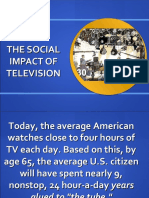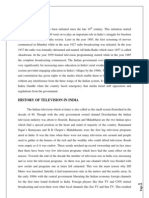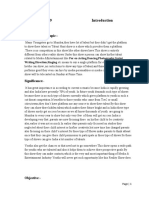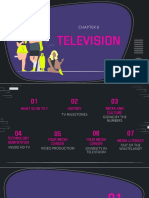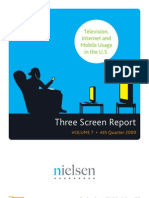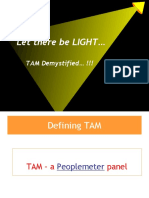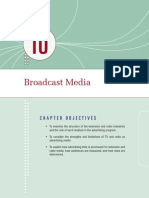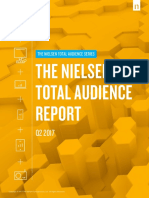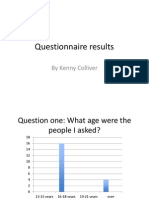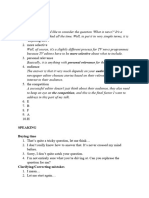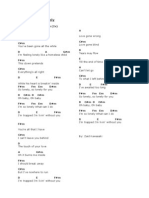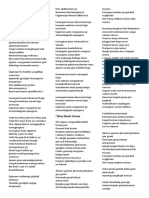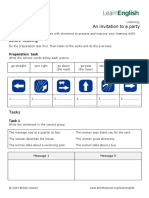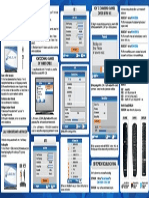INTRODUCTION
Television's mighty grasp on the eyeballs of the viewer is partly due to the human body's inability to react to the transmitted programming. Images from the glowing, pulsing TV screen are simulating, however the nature of the medium does not permit the body to respond appropriately. The body wants to react to the barrage of images, but cannot. This sensory disorientation - the TV watcher is visually and aurally simulated while remaining physically passive - confuses the mind. These conflicting messages and feelings succeed in creating an almost hypnotic trance in the viewer. Todays TV viewers wantand have access to--the best entertainment in more ways and places than ever, and want it on our schedules. If our favorite show is at 8 p.m., and we work late, we want to be able to see it once we get home at 10 p.m. If it's a major season premiere, we may want to host a party to watch it live, and simultaneously talk about it with our friends on Facebook or Twitter. We're not interested in replacing traditional TV, but integrating the use of other screens and technologies with the experience. Our ongoing desire for more content is reflected in our viewing habits and in our appetite for news. The Pew Research Center reports that we are spending an average of 57 minutes per day keeping up with the news in newspapers, radio and television, the same as a decade ago.
The most successful business owners will be the ones who listen to customers thoughts and opinions. As habits change, making TV viewing a more active, or lean forward experience, smart marketers who put new technology to work to keep pace with what viewers want and expect will set themselves apart from the competition. A great part of a housewifes life in a society of ignorance is spent in front of the television. But, it is not only they who enjoy this habit; their husbands and children also spend hours watching television, it being one of the favorite forms of entertainment of a society of ignorance. However, what they watch is most often of no value. The most important thing for them is to pass the time
Page | 1
�and, in their own way, enjoy some brief relief from the anxieties they suffer in their lives. Regardless of whatever else they might be doing, throughout the day, housewives leave the television on. Especially when the soap operas come on, then they are glued to the screen. The romance featured in these soap operas gives them particular enjoyment. For this reason, their daily schedule is organized around the times when these soap operas are broadcast, and if they have to go anywhere, they ensure that they record the episode on videocassette. If they cant, then as soon as they finish what they are doing, they eagerly find out the latest developments that took place on the program from friends or neighbors. Even if they were offered better quality programming and documentaries in which signs leading to faith are displayed, with more intelligent content so as to broaden their horizons, these women, being far removed from the morality of the true religion, would still not give up their soap operas. Because these programs reflect their aspirations, pleasures and their outlook on life so well. Of course, there would be nothing wrong with watching television, if there were better programming; then people could learn Islamic values from it. But, it is wrong as it stands, because of its mindless content, leaving a person heedless of the existence of Allah and the Hereafter. Especially, it is wrong if the housewife cannot tear herself away from watching television to do something more important or useful. These women could do something positive, but never do, nor are they uncomfortable about it, because their lack of sense of purpose and their self-image as housewife is so ingrained.
Page | 2
�Q.1 How old are you? Frequency 19 21 22 - 30 31 40 41 50 Total 10 12 2 1 25 Percent 40.0 48.0 8.0 4.0 100.0 Statistics Valid Missing Mean 25 0 2.7600 Valid Percent 40.0 48.0 8.0 4.0 100.0 Cumulative Percent 40.0 88.0 96.0 100.0
Age
50 40 Age Level 30 20 10 0 Series1 19 21 40 22 - 30 48 31 40 8 41 50 4
The bar chart gives the information that 48% of the respondent ages of 22-30 are the most viewers, respectively 40% the age of 19-21 are also the follower. And the 8% viewers are at the age of 31-40 and 4% viewers are the age of 41-50. Here its clear that the age of 22-30 age peoples are the most viewer of TV.
Page | 3
�Q.2 Gender
Frequency Male Female Total 17 8 25
Percent 68.0 32.0 100.0 Statistics
Valid Percent 68.0 32.0 100.0
Cumulative Percent 68.0 100.0
Valid Missing Mean
25 0 1.3200
Gender
Female 32%
Male 68%
The pie chart gives the information that 68% of the interviewees were male. The diagram makes clear that most of the students were men.
Page | 4
�Q.3 Describe your current occupation? Cumulative Frequency Part time employee full time employee Student Unemployed Total 4 8 12 1 25 Percent 16.0 32.0 48.0 4.0 100.0 Statistics Valid Missing Mean 25 0 2.4000 Valid Percent 16.0 32.0 48.0 4.0 100.0 Percent 16.0 48.0 96.0 100.0
Occupation
50 40
Axis Title
30
20
10 0 Series1
Part time employee 16
full time employee 32
Student
48
Unemployed
4
From the above bar chart it shown that the viewer of the television most of our student and its percentage is 48%, full time employee are 32%, part time employee are 16% and the unemployed viewer are 4%. So the percentage of student are the most viewer of television.
Page | 5
�Q.4 Do you watch satellite television?
Frequency Yes 25
Percent 100.0 Statistics
Valid Percent 100.0
Cumulative Percent 100.0
Valid Missing Mean
25 0 1.0000
Watch TV
Yes 0% No
100%
Here the percentages of satellite television viewer are 100% percentage because of the globalization.
Page | 6
�Q.5 How many hours a day do you watch T.V? Cumulative Frequency Below 1 hour 13 46 Total 5 18 2 25 Percent 20.0 72.0 8.0 100.0 Statistics Valid Missing Mean 25 0 1.8800 Valid Percent 20.0 72.0 8.0 100.0 Percent 20.0 92.0 100.0
Hours saw tv
80 70 60 50
40
30 20 10 0 Below 1 hour 20% 13 46
Series1
72%
8%
The average rate of the television watching hour 1-3 hours in percentage it is 72%, 20% PEOPLE watch below 1 hour and 8% people watch television 4-6 hours.
Page | 7
�Q.6 What would you like to see more on the T.V? Cumulative Frequency Dramas Comedies Documentaries Music Sports Total 10 2 1 3 9 25 Percent 40.0 8.0 4.0 12.0 36.0 100.0 Valid Percent 40.0 8.0 4.0 12.0 36.0 100.0 Percent 40.0 48.0 52.0 64.0 100.0
Statistics Valid Missing Mean 25 0 4.4800
36%
40% Dramas Comedies 12% Documentaries 4% 8% Music Sports
The average rate of like to see more on the T.V are 40% is dramas,36% is sports,12% is music & 8% is comedies,4% is documentaries.
Page | 8
�Q.7 How long do you like a T.V program to last? (In minutes) Cumulative Frequency 10 20 min 21 30 min. 31 40 min 60 + Total Valid Missing Mean 6 7 4 8 25 Percent 24.0 28.0 16.0 32.0 100.0 Statistics 25 0 2.5600 Valid Percent 24.0 28.0 16.0 32.0 100.0 Percent 24.0 52.0 68.0 100.0
32%
24% 10 20 min 21 30 min.
16%
28%
31 40 min 60 +
The average rate of long do you like a T.V program to last are 60+min is 32 %, 21-30 min is 28%,10-20min is 24% & 31-40min is 16%.
Page | 9
�Q.8 Which television channels do you spend the most time watching in one week? Cumulative Frequency Channel I ATN NTV Independent Television Somoy TV Star Plus Star Jalsha Total Valid Missing Mean 1 4 1 3 3 9 4 25 Statistics 25 0 5.3600 Percent 4.0 16.0 4.0 12.0 12.0 36.0 16.0 100.0 Valid Percent 4.0 16.0 4.0 12.0 12.0 36.0 16.0 100.0 Percent 4.0 20.0 24.0 36.0 48.0 84.0 100.0
Chart Title
16% 4% 16% 4% 12% 36% 12% Channel I ATN NTV Independent Television Somoy TV Star Plus Star Jalsha
The average rate of the television channels to spend the most time watching in one week 36% is star plus,16% are ATN & star jalsha,12% are independent TV & channel I & 4% is only somoy TV.
Page | 10
�Q.9. Do you like Advertisement? Frequency Yes No Total 23 2 25 Percent 92.0 8.0 100.0 Statistics Valid Missing Mean 25 0 1.0800 Valid Percent 92.0 8.0 100.0 Cumulative Percent 92.0 100.0
Like ads?
8%
Yes 92% No
The average rates of the like Advertisement are 92% is say YES & 8% is say NO.
Page | 11
�Q.10 Which types of Advertisement you like most? Cumulative Frequency Interesting Funny Drama 3d Total 7 13 3 2 25 Percent 28.0 52.0 12.0 8.0 100.0 Statistics Valid Missing Mean 25 0 2.0000 Valid Percent 28.0 52.0 12.0 8.0 100.0 Percent 28.0 80.0 92.0 100.0
Chart Title
12% 8% 28% Interesting Funny Drama 52% 3d
The pie chart shows that 52% is funny, 28% is interesting, 12% like drama & onely 8% like 3D types of advertisement like most.
Page | 12
�Q.11 If you think the advertisement is most important of product identity? Frequency Yes 25 Percent 100.0 Statistics Valid Missing Mean 25 0 1.0000 Valid Percent 100.0 Cumulative Percent 100.0
0%
Yes 100% No
THE PIE CHART SHOW THAT 100 % IS SAY YES TO THINK THE ADDVERTISEMENT IS MOST IMPORTANT OF PRODUCT IDENTITY.
Page | 13
�Q.12 Do you watch reality TV shows? Cumulative Frequency Yes No Sometimes Total 9 3 13 25 Percent 36.0 12.0 52.0 100.0 Statistics Valid Missing Mean 25 0 2.1600 Valid Percent 36.0 12.0 52.0 100.0 Percent 36.0 48.0 100.0
Watch reality shows?
36% 52%
12% Yes No Sometimes
THE PIE CHART SHOW THAT ARE 52% IS SAY SOMETIMES,36% IS YES & 12% IS SAY NO FOR WATCH REALITY SHOWS.
Page | 14
�Q.13 Which time of the day do you think TV is best?
Frequency Morning Evening Night Total 1 8 16 25
Percent 4.0 32.0 64.0 100.0 Statistics
Valid Percent 4.0 32.0 64.0 100.0
Cumulative Percent 4.0 36.0 100.0
Valid Missing Mean
25 0 3.5600
Which time is the best for tv watching?
4%
32% 64%
Morning Evening Night
THE PIE CHART SHOW THAT 64% IS NIGHT TO THE RESPONDENT,32% IS RESPONE EVENING & ONLY 4% SAY MORNING TO THE TIMES IS THE BEST FOR TV WATCHING. .
Page | 15
�Q.14 Do you like watching the news on TV? Frequency Yes No Total 23 2 25 Percent 92.0 8.0 100.0 Statistics Valid Missing Mean 25 0 1.0800 Valid Percent 92.0 8.0 100.0 Cumulative Percent 92.0 100.0
Like TV news?
8%
Yes No
92%
THE PIE CHART SHOW THAT 92% IS RESPONE OF YES & ONLY 8% IS RESPONSE OF NO TO LIKE TV NEWS.
Page | 16
�Q.15 What is your purpose in watching TV? Cumulative Frequency Getting information Entertainment others Total 7 17 1 25 Percent 28.0 68.0 4.0 100.0 Statistics Valid Missing Mean 25 0 1.8400 Valid Percent 28.0 68.0 4.0 100.0 Percent 28.0 96.0 100.0
What is the purpose of tv Watching?
4% 28% Getting information Entertainment 68% others
THE PIE CHART SHOW THAT 68% IS ENTERTAINMENT, 28% IS GETTING INFORMATION & 4% IS ONLY OTHERS IS THE PURPOSE OF TV WATCHING.
Page | 17
�Q.16 How often do you watch TV?
Frequency Very deeply Deeply Suitably Rarely Total 4 14 4 3 25
Percent 16.0 56.0 16.0 12.0 100.0 Statistics
Valid Percent 16.0 56.0 16.0 12.0 100.0
Cumulative Percent 16.0 72.0 88.0 100.0
Valid Missing Mean
25 0 2.2400
12% 16%
16%
Very deeply Deeply
56%
Suitably Rarely
THE PIE CHART SHOW THAT 56% IS DEEPLY, 16% ARE VERY DEEPLY & SUITABLY & 12% IS SAY RARELY DO OFTEN WATCH TV.
Page | 18
�Q.17 Do you have anxiety or dissatisfaction towards the media? Cumulative Frequency Very much Yes, but t is a reluctant problem. Satisfied No opinion Total 14 5 25 Statistics Valid Missing Mean 25 0 2.9200 56.0 20.0 100.0 56.0 20.0 100.0 80.0 100.0 1 5 Percent 4.0 20.0 Valid Percent 4.0 20.0 Percent 4.0 24.0
60 50
40
30 20 10 0 Very much Yes, but t is a reluctant problem. 20 Satisfied No opinion
Series1
56
20
The table gives the information that 56% is satisfied,20% are Yes, but t is a reluctant problem & No opinion & 4% is very much to have anxiety or dissatisfaction towards the media.
Page | 19













